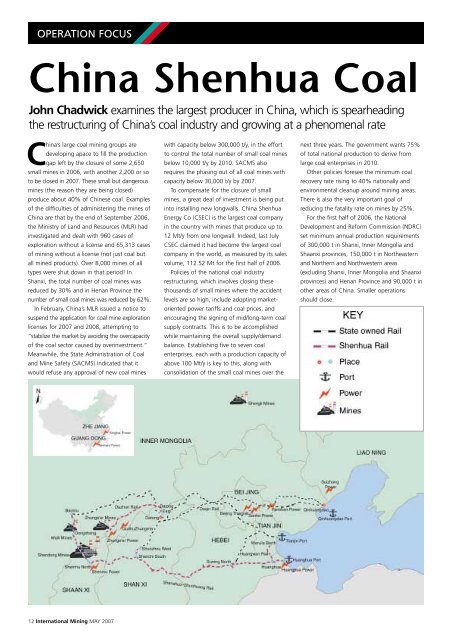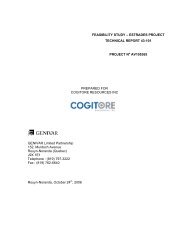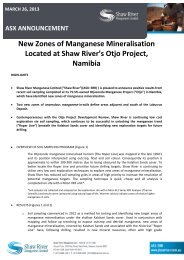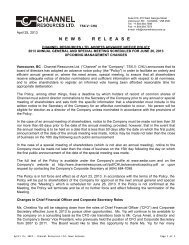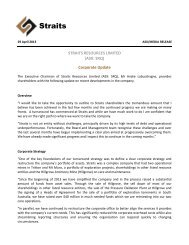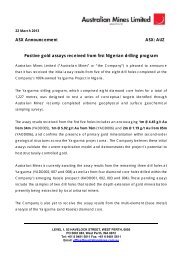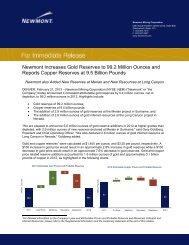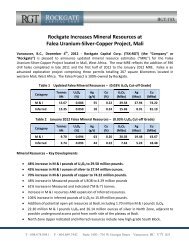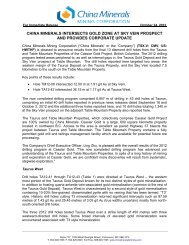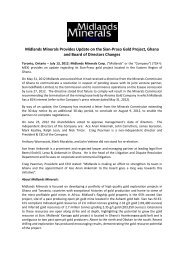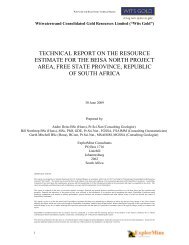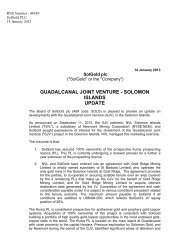Create successful ePaper yourself
Turn your PDF publications into a flip-book with our unique Google optimized e-Paper software.
OPERATION FOCUS<br />
<strong>China</strong> <strong>Shenhua</strong> <strong>Coal</strong><br />
John Chadwick examines the largest producer in <strong>China</strong>, which is spearheading<br />
the restructuring of <strong>China</strong>’s coal industry and growing at a phenomenal rate<br />
<strong>China</strong>’s large coal mining groups are<br />
developing apace to fill the production<br />
gap left by the closure of some 2,650<br />
small mines in 2006, with another 2,200 or so<br />
to be closed in 2007. These small but dangerous<br />
mines (the reason they are being closed)<br />
produce about 40% of Chinese coal. Examples<br />
of the difficulties of administering the mines of<br />
<strong>China</strong> are that by the end of September 2006,<br />
the Ministry of Land and Resources (MLR) had<br />
investigated and dealt with 960 cases of<br />
exploration without a license and 65,313 cases<br />
of mining without a license (not just coal but<br />
all mined products). Over 8,000 mines of all<br />
types were shut down in that period! In<br />
Shanxi, the total number of coal mines was<br />
reduced by 30% and in Henan Province the<br />
number of small coal mines was reduced by 62%.<br />
In February, <strong>China</strong>’s MLR issued a notice to<br />
suspend the application for coal mine exploration<br />
licenses for 2007 and 2008, attempting to<br />
“stabilize the market by avoiding the overcapacity<br />
of the coal sector caused by overinvestment.”<br />
Meanwhile, the State Administration of <strong>Coal</strong><br />
and Mine Safety (SACMS) indicated that it<br />
would refuse any approval of new coal mines<br />
12 International Mining MAY 2007<br />
with capacity below 300,000 t/y, in the effort<br />
to control the total number of small coal mines<br />
below 10,000 t/y by 2010. SACMS also<br />
requires the phasing out of all coal mines with<br />
capacity below 30,000 t/y by 2007.<br />
To compensate for the closure of small<br />
mines, a great deal of investment is being put<br />
into installing new longwalls. <strong>China</strong> <strong>Shenhua</strong><br />
Energy Co (CSEC) is the largest coal company<br />
in the country with mines that produce up to<br />
12 Mt/y from one longwall. Indeed, last July<br />
CSEC claimed it had become the largest coal<br />
company in the world, as measured by its sales<br />
volume, 112.52 Mt for the first half of 2006.<br />
Policies of the national coal industry<br />
restructuring, which involves closing these<br />
thousands of small mines where the accident<br />
levels are so high, include adopting marketoriented<br />
power tariffs and coal prices, and<br />
encouraging the signing of mid/long-term coal<br />
supply contracts. This is to be accomplished<br />
while maintaining the overall supply/demand<br />
balance. Establishing five to seven coal<br />
enterprises, each with a production capacity of<br />
above 100 Mt/y is key to this, along with<br />
consolidation of the small coal mines over the<br />
next three years. The government wants 75%<br />
of total national production to derive from<br />
large coal enterprises in 2010.<br />
Other policies foresee the minimum coal<br />
recovery rate rising to 40% nationally and<br />
environmental cleanup around mining areas.<br />
There is also the very important goal of<br />
reducing the fatality rate on mines by 25%.<br />
For the first half of 2006, the National<br />
Development and Reform Commission (NDRC)<br />
set minimum annual production requirements<br />
of 300,000 t in Shanxi, Inner Mongolia and<br />
Shaanxi provinces, 150,000 t in Northeastern<br />
and Northern and Northwestern areas<br />
(excluding Shanxi, Inner Mongolia and Shaanxi<br />
provinces) and Henan Province and 90,000 t in<br />
other areas of <strong>China</strong>. Smaller operations<br />
should close.
<strong>China</strong>’s total run-of-mine (ROM) coal<br />
production in 2005 was 2,190 Mt, and in the<br />
first nine months of 2006 was 1,478 Mt. In<br />
2005, what the MLR describes as ‘large and<br />
super-large coalfields’ were discovered at<br />
Qingyang (Gansu Province), Yuzhou (Henan<br />
Province), Hengshui (Hebei Province), Changji<br />
(Xinjiang Autonomous Region) and Yushe<br />
(Shanxi Province). During the year a number of<br />
new coal development projects were initiated<br />
or came on stream, undertaken by CSEC,<br />
Huaneng Group, Pingdingshan <strong>Coal</strong> Group,<br />
Yanzhou <strong>Coal</strong> Group and others.<br />
NDRC says total production will be capped<br />
at 2,600 Mt/y by 2010, and it forecasts demand<br />
in 2007 will rise 4.2% to 2,500 Mt, fuelling<br />
about 70% of <strong>China</strong>'s power output. “The key<br />
missions are to control output, form big<br />
players, consolidate small and medium-size<br />
suppliers and eliminate those with low recovery<br />
rates and poor safety,” the commission said in<br />
its outline of the 11th Five-Year Plan (2006-<br />
2010) for the coal industry. The 2,600 Mt/y<br />
cap would mean limiting the average annual<br />
rate of increase in production to 2%, which<br />
seems unlikely with recent annual increases of<br />
up to 11%. By 2010, these planners also<br />
expect small mines to provide only 700 Mt<br />
(27%), while large complexes produce 1,450<br />
Mt (56%) and medium size mines produce<br />
450 Mt (17%).<br />
CSEC the leader<br />
CSEC’s biggest production group, <strong>China</strong><br />
<strong>Shenhua</strong> Shendong <strong>Coal</strong>, exemplifies the huge<br />
achievements of the company. Shendong’s<br />
eight mines last year produced 107 Mt, but<br />
only 12 years before, in 1994, there was<br />
nothing. Last August Shendong’s Bulianta mine<br />
(one of the world’s biggest underground<br />
operations) produced 2.1 Mt of raw coal in the<br />
month (2 Mt clean), breaking its own coal<br />
production record. In 2006, it became the first<br />
underground coal mine in the world to<br />
produce over 20 Mt.<br />
Despite its rapid growth, Shendong has not<br />
forsaken environmental management and in<br />
2005 was a winner as one of <strong>China</strong>’s best<br />
enterprises for environmental protection. Even<br />
more important, CSEC is a leader in mine<br />
safety. For the first half of 2006, its fatality<br />
rate/Mt was 0.028, compared with 0.6 for the<br />
key state-owned mines and the national<br />
average of 2.2.<br />
As well as being the largest coal producer,<br />
CSEC is also the largest export coal producer in<br />
<strong>China</strong>, and has the largest reserves of quality<br />
coal reserve in <strong>China</strong>. In 2005, CSEC’s<br />
marketable coal reserves were 5,740 Mt. CSEC<br />
owns dedicated rail lines and ports, being the<br />
only coal company in <strong>China</strong> that owns and<br />
operates a large-scale integrated coal<br />
transportation network. It controls one of the<br />
two primary dedicated eastbound coal freight<br />
rail lines in <strong>China</strong>, which not only helps solve<br />
the transportation bottleneck that faces<br />
Chinese coal companies, but also provides<br />
great synergy as well as transportation cost<br />
advantages. CSEC also has a sizeable and<br />
rapidly growing power generation business,<br />
complementary to its coal business.<br />
<strong>China</strong>’s Ministry of Railways is also working<br />
to improve coal transport. Its priorities for this<br />
year are the construction of rail lines for<br />
passenger transport, coal transport and<br />
inter-regional connections. It has allocated<br />
RMB332 billion to construct new lines and the<br />
purchase of rolling stock this year.<br />
CSEC currently operates through four<br />
mining groups – Shendong, Wanli, Zhunge’er<br />
and Shengli – with a total of 21 operating<br />
mines in western and northern <strong>China</strong>.<br />
Shendong and Wanli are primarily underground<br />
mines while the Zhunge’er and Shengli<br />
mines are open pits. Shendong is the largest of<br />
the 13 large-scale coal bases in <strong>China</strong>.<br />
In 2005, CSEC's commercial (clean) coal<br />
production exceeded 121 Mt, representing a<br />
year-on-year increase of 20.1 Mt, or an<br />
increase of 19.8%. <strong>Coal</strong> sales volume amounted<br />
to 144 Mt, representing a year-on-year<br />
increase of 17.45 Mt, or an increase of 13.8%.<br />
In 2006, clean coal production rose over 15<br />
Mt, to 136.6 Mt and sales rose to 171.1 Mt.<br />
Exports were 23.9 Mt. During the year, CSEC<br />
benefited from a steady increase in coal price.<br />
Its average production cost was RMB57.3/t in<br />
2005 and for the first half of 2006 it was<br />
05/07<br />
RMB56.3/t (when the costs broke down as<br />
RMB10.3/t for raw materials, fuel and power;<br />
RMB7.7/t for labour; RMB8.9/t for maintenance<br />
and RMB14.1/t, others). Adding in transportation<br />
costs, the totals were RMB131.7/t and<br />
RMB125.1/t, respectively. Those same unit<br />
costs including third party coal purchases were<br />
RMB145/t and RMB149.8/t, respectively.<br />
In 2005, CSEC’s raw coal production<br />
accounted for 6.2% of national production and<br />
12% of the national thermal coal production,<br />
and its export sales accounted for 33% of<br />
national exports.<br />
CSEC plans to achieve a clean coal output<br />
level of 170 Mt by next year, and to exceed<br />
200 Mt by 2010. Longer term, the goal is 800<br />
Mt by 2020. The annual rail capacity of CSEC<br />
is targeted to reach 200 Mt/y and port<br />
shipment capacity 140 Mt/y by 2008. Total<br />
installed power generation capacity is to reach<br />
20,000 MW by 2010.<br />
Capital expenditure between 2006 and<br />
2008 will be split between the coal mines<br />
(40%), power generation (38%) and railways<br />
and ports (22%). CSEC intends to invest<br />
RMB30.4 billion in its coal mines, mainly for<br />
technology upgrades, equipment replacement<br />
and the construction of key projects such as<br />
the Buertai underground mine in the Wanli<br />
<strong>Coal</strong> Group and the Ha’erwusu open pit. It<br />
was November 2005 that CSEC announced<br />
the start of construction at the Ha’erwusu<br />
A Bucyrus 8750 dragline like this is the first large<br />
dragline of any manufacture to be sold into <strong>China</strong>. It<br />
is also the first dragline to be entirely powered with a<br />
Siemens AC static drive system and with a direct<br />
(gearless) drive system for hoist and drag motions.<br />
MAY 2007 International Mining 13
OPERATION FOCUS<br />
mine, located in the Zhunge’er coalfield near<br />
Hohhot, Inner Mongolia, and adjacent to<br />
Heidaigou mine. <strong>Coal</strong> transport from<br />
Ha’erwusu will use the Da-Zhun rail line, which<br />
is one part of CSEC’s dedicated rail system.<br />
The estimated probable reserves are some<br />
1,585 Mt under the <strong>China</strong> national standard.<br />
The coal characteristics are favourable for<br />
power generation. The design capacity is 20<br />
Mt/y and will include a processing plant.<br />
As part of the Ha’erwusu development,<br />
Terex is delivering a large number of Unit Rig<br />
trucks. The trucks are being delivered and<br />
on-going service and support provided by Terex<br />
NHL Mining Equipment Co, a new joint<br />
venture company established between Terex<br />
and Inner Mongolia North Hauler Joint Stock<br />
Co, located in Baotou, Inner Mongolia. The<br />
joint venture company will also participate in<br />
certain aspects of the fabrication and<br />
component manufacturing for these trucks.<br />
The Terex contract, valued at some $150<br />
million, covers 18 MT4400AC 240-t class<br />
dump trucks and 37 MT5500B 360-t class<br />
trucks. They are to be delivered to the mine<br />
between January and September this year. In<br />
January 2006 Bucyrus International was the<br />
successful bidder to supply four electric rope<br />
mining shovels to Ha’erwusu. The public bid<br />
release indicated that the scope of supply<br />
would include four 55-60 m3 shovels.<br />
Neighbouring Heidaigou is the second<br />
largest open-pit coal mine in <strong>China</strong>. The mine<br />
uses what CSEC describes as ‘the truck and<br />
Joy Mining is delivering a 7LS shearer and the AFC for a new<br />
longwall at Shendong’s Yujialiang mine. These machines will<br />
operate on the longest face thus far developed in the world,<br />
at 413 m.<br />
14 International Mining MAY 2007<br />
conveyor mining method’ but is in the process<br />
of introducing dragline mining. It achieved<br />
clean coal production of 19.77 Mt, with a<br />
resource recovery rate of 98%, in 2005.<br />
It was Bucyrus that won the Heidaigou<br />
dragline contract which, the company said,<br />
“marks the start of a new era in dragline<br />
technology. The dragline, a model 8750 with a<br />
90 m3 bucket, is the first large dragline of any<br />
manufacture to be sold into <strong>China</strong>. It is also<br />
the first dragline to be entirely powered with a<br />
Siemens AC static drive system and with a<br />
direct (gearless) drive system for the hoist and<br />
drag motions.”<br />
The mine also chose to have the productivity<br />
enhancing, maintenance reducing “D3 ”(Direct<br />
Drive for Draglines) technology. Stuart Cotterill,<br />
Vice President and General Manager for <strong>China</strong><br />
Operations, highlighted the selection of<br />
Bucyrus, “We are truly appreciative of the<br />
approach taken by Zhunge’er in the selection<br />
of this dragline following considerable<br />
technical discussions and visits to several<br />
mining operations. The recognition of the long<br />
term benefits of the machine's features is a<br />
tribute to their appreciation of the latest<br />
technological advances.<br />
Bucyrus and Siemens worked closely together<br />
to make D3 a reality. The application of D3 is<br />
made possible through the use of Siemens'<br />
AFE (Active Front-End) AC electrical technology.<br />
The maximum achievable production improvement<br />
that can be gained by using D3 is a function of<br />
the specific dragline configuration and its use<br />
in the mine plan. An analysis of several existing<br />
dragline operations has identified significant<br />
productivity increases, well in excess of 20%.<br />
Substantial productivity increases such as this<br />
provide opportunities to further reduce mining<br />
costs by optimizing overburden removal<br />
methods. Tim Sullivan, President and COO of<br />
Bucyrus commented at the time, “Thirty years<br />
ago Bucyrus machines were the first western<br />
manufactured shovels and drills to be sold to<br />
the <strong>China</strong> market and many of those units still<br />
operate today. We are extremely pleased to<br />
follow that tradition by supplying the first large<br />
walking dragline.<br />
In November last year CSEC announced that<br />
the construction of a new coal processing plant<br />
at the Zhunge’er Heidaigou open-pit mine had<br />
been completed. Now, the coal processing<br />
capacity at Zhunge’er has been upgraded to<br />
20-25 Mt/y, making it the largest such facility<br />
in Asia.<br />
<strong>Coal</strong> infrastructure<br />
The RMB16.6 to be invested by CSEC in railways<br />
and ports between 2006 and 2008 is mainly to<br />
increase the capacities of the Shen-Shupo<br />
and Da-Zhun railways, and to construct key<br />
projects such as the Huang-Wan railway and<br />
the Tianjin coal terminal. Most of the RMB28.6<br />
billion in power generation spending is for<br />
new capacity at the Ninghai, Huanghua,<br />
Taishan and Jingjie power projects.<br />
CSEC’s coal mine merger and acquisition<br />
plans include gradually completing the acquisition
STATIONARY<br />
RECLAIM<br />
McLanahan Feeder-Breakers are designed with cutting edge<br />
features and concepts. We were the first manufacturer to eliminate<br />
chain drives and shear pins and incorporate the use of direct drive<br />
reducers and hydraulic motors to power the breaker and chain<br />
conveyor system. But beyond that, we have set the new standard for<br />
providing the most rugged and reliable Feeder-Breakers ever made.<br />
UNDERGROUND<br />
CRAWLER MOUNTED<br />
Call Or Visit Our Website Today To Learn<br />
How You Can Improve Your Operations<br />
With A McLanahan Feeder-Breaker!<br />
MINERAL PROCESSING DIVISION<br />
EQUIPMENT, SYSTEMS & PROCESS INNOVATION – SINCE 1835<br />
WORLD HEADQUARTERS 200 Wall Street, Hollidaysburg, PA 16648 USA<br />
Ph: 814-695-9807 • Fax: 814-695-6684 • E-mail: sales@mclanahan.com<br />
AUSTRALIAN OFFICE 8/9 Tonella Centre, 125 Bull Street, Newcastle West, NSW 2302 Australia<br />
Ph: +02 49 248 248 • Fax: +02 4926 2514 • E-mail: sales@mclanahan.com.au<br />
www.mclanahan.com
OPERATION FOCUS<br />
of Xi Sanju, Baorixile of Inner Mongolia, Ningmei,<br />
<strong>China</strong> <strong>Shenhua</strong> Xinjiang, Hungyuchuan <strong>Coal</strong>field,<br />
Mengxi <strong>Coal</strong> Chemical, Wuhai Coking <strong>Coal</strong><br />
Chemical and the Jinshen project. Overseas,<br />
CSEC is looking at coal business opportunities<br />
in Vietnam, Mongolia and Australia.<br />
The Shendong giant<br />
The Shendong mines use fully-mechanized<br />
longwall mining technology and centralized<br />
production management and safety systems.<br />
The longwall panels range from 240 to 360 m<br />
(and now going to over 400 m) in width and<br />
from 4,000 to 6,000 m in length. Among the<br />
Shendong mines, there are three working<br />
faces each with an annual output of at least<br />
10 Mt. Shendong’s commercial coal production<br />
rocketed from 47.1 Mt in 2002 to 94.95 Mt in<br />
2005. With the commencement of operations<br />
of Halagou’s longwall system at the end of<br />
2004, Shendong had built five 10-Mt/y mines<br />
– Daliuta, Bulianta, Yujialiang, Halagou and<br />
Shangwan. In 2005, Shendong’s coal production<br />
accounted for 78.2% of CSEC’s total output.<br />
Mining efficiency at Shendong’s underground<br />
mines has seen steady and significant<br />
improvement. In 2004 it was 28,320<br />
t/y/employee, and then rose to 29,813 t in<br />
2005 and for the first half of 2006 was up at<br />
31,502 t. Joy Mining is a major supplier to<br />
Shendong, where its fleet includes 25 shearers,<br />
24 AFCs and five PRS. The majority of the Joy<br />
units are 7LS or 6LS shearers.<br />
Joy Mining is delivering a 7LS1A shearer<br />
and the AFC for a new longwall at Shendong’s<br />
Yujialiang mine. These machines will operate<br />
on the longest face thus far developed in the<br />
world, at 413 m.<br />
In January this year, Poland’s Kopex also<br />
signed a $33.15 million contract for this<br />
project that covers the delivery of Tagor (part<br />
of the ZZM-Kopex Group) longwall<br />
mechanized roof supports together with an<br />
electro-hydraulic monitoring and control<br />
system to be supplied by Marco, to be<br />
completed by the end of October this year.<br />
Shendong’s future plans include expansion<br />
into adjacent areas to further enhance<br />
exploration of resources in the southern area<br />
of Shendong. The coal group is also promoting<br />
its own equipment manufacturing and recently<br />
developed the first Chinese built 40-t shield<br />
mover, together with the Taiyuan Branch of<br />
<strong>China</strong> <strong>Coal</strong> Research, which has now gone to<br />
work underground in the Shendong mines.<br />
CTL and more<br />
CSEC is set to become the world leader in<br />
coal-to-liquids (CTL). It started developing its<br />
CTL programme at a pilot plant in Shanghai,<br />
16 International Mining MAY 2007<br />
which now has successfully achieved<br />
sustainable output of diesel oil and gasoline<br />
from a feed of 6 t/d of coal. This facility has<br />
allowed CSEC to become comfortable with the<br />
technology and to accumulate know-how on<br />
cost control and operations management.<br />
Shendong is developing the first commercial<br />
project in Inner Mongolia. Project construction<br />
was 50% complete at the beginning of 2006,<br />
with the coal liquefaction reactors (each<br />
weighing 2,250 t) successfully installed. Full<br />
production is expected by the end of this year,<br />
some 20,000 barrels/d (b/d) of oil from coal.<br />
However, the plans go far beyond this one<br />
plant. CSEC plans to operate eight liquefaction<br />
plants by 2020. Together they will yield in<br />
excess of 30 Mt/y of CTL oil, which is estimated<br />
to be sufficient to replace over 10% of<br />
<strong>China</strong>’s projected oil imports.<br />
These CTL plans are not only fascinating in<br />
their sheer size; they also involve very<br />
interesting technology. Up to now, all the<br />
world’s CTL has involved the Fischer-Tropsch<br />
(FT) process, which requires coal to be turned<br />
into synthetic gas, and then to be liquefied.<br />
CSEC is using a process developed by Friedrich<br />
Bergius, a decade before the FT process, which<br />
takes the coal directly to liquids. It is certainly<br />
not unproven as it was well used in Nazi Germany.<br />
The <strong>China</strong> <strong>Coal</strong> Research Institute in Beijing<br />
estimates the Bergius process yields significantly<br />
more fuel from each tonne of coal. It expects<br />
the process to capture more than 55% of the<br />
coal’s energy, compared to just 45% for FT.<br />
Basically; the bulk of the coal is pulverized and<br />
blended with CTL oil. It is then exposed to<br />
hydrogen and heated to 450°C.<br />
The benefits of Bergius do not come<br />
without some downsides. Direct liquefaction is<br />
far more complex than FT, requiring separate<br />
power and gasification plants. Also, a great<br />
deal of recycling of oil, hydrogen and coal<br />
sludge is necessary, between different sections<br />
of the plant. CSEC is bravely taking a massive<br />
engineering and economic risk with this first<br />
$1.5 billion CTL plant. Thus far the signs are<br />
promising. If CSEC has got it right, which<br />
seems likely, it will be a great boost for <strong>China</strong>,<br />
and for the world, as its success would surely<br />
lead to more projects that can harness the<br />
energy potential of coal so cleanly. Also, CSEC<br />
says the cost of its synthetic oil will see it make<br />
a profit at a price of about $30/barrel.<br />
However, water could be the ultimate<br />
spanner in the works of these CTL plans. The<br />
Berguis process needs large quantities of water<br />
and <strong>China</strong> has great water problems.<br />
To be safe, the company is also working<br />
with the established FT technology, in partnership<br />
with both Shell and Sasol in northern <strong>China</strong>.<br />
For example, in the Nindong coalfield – one of<br />
13 major coal centres approved for construction<br />
by the Chinese Government, <strong>Shenhua</strong> Ningxia<br />
<strong>Coal</strong> Group (SNCG) and Shell are jointly studying<br />
the technical and commercial feasibility of a<br />
CTL plant with a production capacity of<br />
70,000 b/d of oil and chemical products.<br />
SNCG also, in January, signed a contract for<br />
Siemens Power Generation (PG) Group to<br />
supply key gasification equipment for a<br />
coal-based dimethyl ether project with a<br />
planned output of 830,000 t/y. Siemens PG<br />
also signed a Memorandum of Understanding<br />
to provide equipment for SNCG’s coal-based<br />
propylene project that when completed will be<br />
one of the largest in the world.<br />
In June 2006, in Cape Town, South Africa,<br />
Sasol signed a co-operation agreement with a<br />
consortium led by CSEC for proceeding with<br />
the second stage of feasibility studies to<br />
determine the viability of an 80,000 b/d CTL<br />
plant in Shaanxi Province, about 65 km west of<br />
Beijing. Sasol signed a similar agreement for<br />
another 80,000 b/d CTL project in the Ningxia<br />
Hui Autonomous region, about 1,000 km west<br />
of Beijing, with SNCG the previous day.<br />
Sasol noted, “the drive towards coal for<br />
energy security has been endorsed at the<br />
highest levels in <strong>China</strong> and CTL conversion<br />
technology, in particular, has been earmarked<br />
as having the potential to reduce dependence<br />
on the importation of crude oil and refined<br />
products. <strong>Coal</strong> utilization technologies have<br />
been flagged in the 11th Five Year Plan as an<br />
area for policy intervention and support.”<br />
Having produced more than 1,500 million<br />
barrels of oil equivalent fuel in South Africa,<br />
Sasol is recognized as the world leader in<br />
producing fuel from coal, with an unparalleled<br />
track record of more than 50 years of proven<br />
commercial CTL experience. But, Sasol may yet<br />
lose its crown to CSEC if its Bergius projects<br />
take off.<br />
The combined capacity of these two<br />
proposed Sasol projects, each with a nominal<br />
capacity of delivering 80,000 b/d of liquid fuel,<br />
is roughly equivalent to that of Sasol’s existing<br />
Secunda facility in South Africa.<br />
Sasol reported, “the initial pre feasibility<br />
studies confirmed all key drivers are in place<br />
for establishing a viable CTL business in <strong>China</strong><br />
using Sasol’s low-temperature FT technology.<br />
Each plant is expected to cost more than $5<br />
billion. Should these projects go ahead, they<br />
could be brought into operation as early as<br />
2012. The second stage feasibility studies will<br />
go into more detail in determining capital cost,<br />
feedstock cost, water supply and market conditions<br />
and will also determine most of the<br />
major commercial and funding issues.” IM


